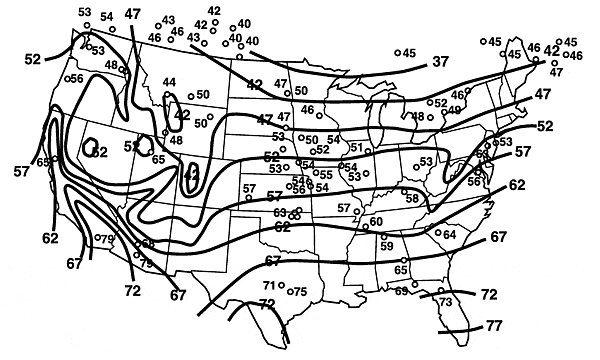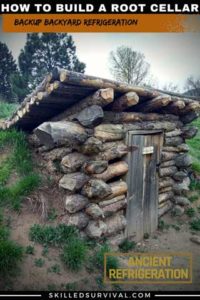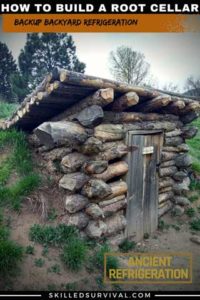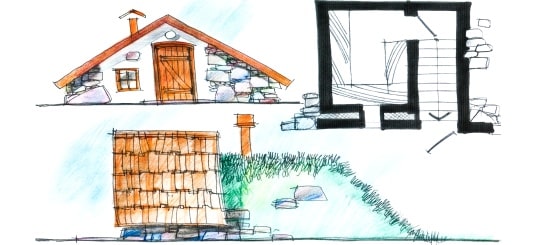Step By Step Guide To Build A Backyard Root Cellar For Survival
Figuring out how to build a root cellar is not a new trick.
In fact, it’s an ancient one.
It’s one of the oldest survival tricks in the book.
But is utilizing the earth for refrigeration still necessary?
In America, there’s an appliance called a refrigerator, duh!?
Our $3,000 stainless refrigerators and chest freezers take care of ALL our food preservation needs, right?
Plus, we have an overabundance of reliable power to run those things forever; everyone knows that.
No one needs to (or cares to) store their food underground anymore, right?
WRONG. I care, and you should too.
So today, we’re going to cover the following topics:
TABLE OF CONTENTS
Why Root Cellars Are Still Important
How Underground Food Storage Works
Two Main Types Of Root Cellars
How To Build A Root Cellar
What You Should Store In It
Organizing The Interior Space
Root Cellar Food Organization
5 Dangerous Root Cellar Enemies
How To Hide Your Root Cellar
Maintaining Your Root Cellar Food

Are You Ready For The Tough Times Ahead? Take My 60 Sec Quiz To See If You’re Part Of ‘The Fragile Masses’ Or Not… Start Quiz Now!
Why Root Cellars Are Still Important
When humans discovered they could increase the shelf life of their food by storing it underground, society was revolutionized.
Suddenly, humans could preserve grains, nuts, fresh fruit, and vegetables for longer periods.
Now immediate food consumption was no longer necessary; having to gorge on it all before it went bad.
Instead, we could now stockpile and preserve our harvests in root cellars prepping for the lean winter months.
It’s the technology that frontier families used to maintain a healthy diet and avoid starvation.
But wait, don’t refrigerators do that nowadays? Yes, but with one big difference – refrigerators depend on electricity.
This makes refrigerators very convenient – until you lose power.
So convenient, in fact, that our society has all but lost this old technology, knowledge, and know-how.
This is a damn shame because there are so many reasons why a backup supply of healthy food is extremely useful – even, dare I say, life-saving.
Be it a massive wildfire, contagious disease, worldwide financial collapse, or an EMP strike.
If any of these horrible events are bad enough and last long enough, having a backup food preservation system may evolve from a fun hobby to a survival necessity.
And while having a backyard root cellar is not a guarantee of survival success, not having one may lead to starvation.
This ancient survival technique may separate those who thrive from those who perish in a “shit-hits-the-fan” scenario.
So a root cellar is an excellent off-grid food preservation system. It’s pretty much a requirement for anyone concerned about losing grid power for good…
If you’re serious about being prepared for anything, you need to add a root cellar to your lifestyle.
But building a root cellar is not a quick project and one you shouldn’t rush.
You need to take your time for proper planning. Because if you don’t, chances are good that you’ll make mistakes. And food storage mistakes can jeopardize all of your food stockpiling efforts.
↓ The Building Of Our Root Cellar ↓
How Underground Food Storage Works
Root cellars ALL have one thing in common. They take advantage of stable underground temperatures! Why underground? It all has to do with the seasonal variation in temperatures.
As you dig down into the earth, the layers of soil between you and the surface act as a blanket insulator from the surface.
For example, in the hot summer, underground temps are much cooler than the surface.
In the winter, a few feet underground is much warmer than a howling blizzard outside.
And you don’t need to dig far to get the benefits…
In fact, in most U.S. regions, at just 10 feet under the surface, you’ll constantly find cool 50-60 degrees, soil temps.

Approximate Soil Temps At 10 Feet Underground
A root cellar takes advantage of these stable, cool temperatures.
And temperature control is an important component in prolonging the shelf life of perishable foods.
Because we all know that cool temperatures extend our perishable food’s shelf life.
For proof of this, leave your milk out on the counter all afternoon in the summer. Near-instant spoilage, while that same milk will last weeks in a cool refrigerator.
A root cellar is nature’s refrigerator without the need for chemical refrigerants or electricity.
And that’s the simple beauty of underground food storage; it extends your food’s shelf life without depending on modern technologies.
But there’s a bit more to it than that…
Using the earth’s lower temperatures is smart, but there are unique challenges you’ll need to overcome to do so successfully.
↓ Everything You Need To Know About Root Cellaring↓
As A Way To Introduce You To Skilled Survival, We’re Giving Away Our #78 Item Complete Prepper Checklist. Click Here To Get Your FREE Copy Of It.
2 Main Types Of DIY Root Cellars
Depending on your time, energy, and funds, there are two main types of root cellars to choose from: small and large.
Small underground food storage systems primarily consist of buried containers, while larger setups typically include a separate building.
So let’s start with the quick, down, and dirty option first; the small buried root cellar container.
The Small Buried Root Cellar Container
This option is similar to burying a survival cache.
But instead of storing gear and equipment, with this option, you’re focusing on storing food.
Remember, anything stored underground at a depth of several feet will stay at a consistently cool temperature between 50-55 degrees F (regionally dependent).
The best containers for this method are the ones not susceptible to water damage or degradation.
Naturally, that eliminates wood crates or cardboard boxes because, over the course of time, natural processes will eat away at these containers and eventually devour whatever’s inside.
Instead, using metal garbage cans, plastic drums, or plastic storage totes is the best option.
Just ensure the container is made of strong materials to prevent collapse and won’t degrade when in contact with moisture for extended periods.
This straightforward method of underground food storage is the easiest on a tight budget. It’s also the quickest to achieve, and acquiring materials is not difficult.
It’s also the closest method to the original root cellar!
When Indians and native Australians buried their food, they did so in clay pots, but they surely would have used waterproof plastic containers if available. But for them, plastic was still centuries away.
Note: if you live in freezing climates, expect your buried food container to be inaccessible during the cold months. When the ground freezes, it becomes difficult or nearly impossible to dig it back up.
Also, extremely low temperatures present a liability for sealed containers; anything stored in a jar, can, or bottle will likely freeze and burst its container. Food for thought!
↓ Cool Ideas For Inexpensive and Easy-to-Make Root Cellars ↓
The limitations of these smaller containers become obvious once you want to expand your underground food storage supply.
Plus, it will be a royal pain to dig them back up regularly to check on your food and rotate your foods (more details later).
So if you want a single large root cellar instead of many smaller ones, you need a larger walk-in backyard root cellar.
One you can fill to the brim with food and wait for the worst.
Image Source
The Backyard DIY Root Cellar
A walk-in-style root cellar is a step up from buried caches. But they do require a bit more time and money.
Here’s a quick overview of how to build a root cellar and how it should function once complete.






